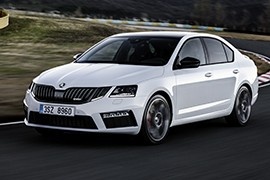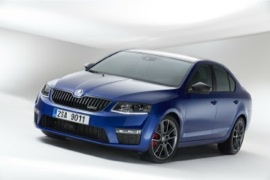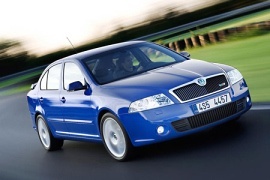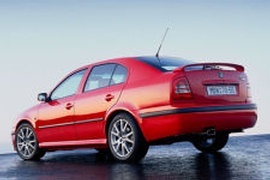
SKODA Octavia RS
Generations Timeline, Specs and Pictures

The third generation of the Octavia RS was introduced in 2013 and the Czech carmaker considered a refresh for it in 2016, along with the rest of the range.
While the first generation of the Octavia RS was a surprise for everyone, its successors were not, but that didn’t make them less appreciated. Its fans were always eager to see the new version, and it was considered a hot-family-hatchback.
The Golf was a traditional hatchback due to its almost vertical tailgate. On the other hand, Skoda built the Octavia with a sloped, fastback-style liftgate to make it more practical for family use. In the RS trim, the medium-sized Czech vehicle featured a more aggressive front fascia with a black grille at the front. Its headlights stirred many talks since they resembled those installed on the Mercedes-Benz E-Class from the same era. But the angular style was typical for the Czech brand, a nation well-represented in the cubist-style design. Its 17” light-alloy wheels were fitted as standard and sported a unique design for the RS version. The carmaker installed a small wing on the tailgate and a pair of chromed exhausts under the bumper in the back.
Inside, the RS featured specific high-bolstered seats with integrated headrests and upholstered in a leather/fabric combination as standard or with Alcantara as an option. The polished-aluminum pedals were more visible thanks to the standard interior ambient lighting.
Under the hood, the Octavia RS was available with a choice of diesel and gasoline engines. While the sportiest one was the 230 hp gasoline version (10 hp more than the non-facelifted version), the 184 TDI was the most fuel-efficient.

The Skoda Octavia RS may have started as more of an experiment for the Czech carmarket, but now enthusiasts expect all the best from the third-generation model, since its predecessors built a strong reputation.
The Octavia now needs to be more than just a Volkswagen Golf GTI in sedan form and wearing new badges, with Skoda assuring us that the car has its own personality.
If we are to talk numbers, the new Octavia RS sprints to 100 km/h (62 mph) in 6.8 seconds, managing to beat a few hot hatches at this game. Should the driver insist on pushing the throttle, the speedometer needle will climb to 248 km/h (154 mph), a value that’s respectable by any standards.
Those opting from frugality can choose the diesel version, which completes the 0 to 100 km/h run in 8.1 seconds and keeps on accelerating until it hits 232 km/h (144 mph).
Mixing practicality with driving dynamics has never been easy, but the Octavia matches the aforementioned numbers with a boot that measures a whopping 590 liters (20.8 cubic feet).
It also comes with all the all the other benefits of the new VW Group MQB modular platform, such an increased rigidity, which, among others, makes the handling more lively.

When Skoda introduced the first generation of the Octavia RS, it didn’t know how the public will react, and the results exceeded its expectations, so it decided on continuing the saga with a new generation.
The Czech carmaker introduced the second generation of the Octavia hatchback in 2004 but waited until next year to launch the sportiest version for that, the RS. Unlike the first generation, the Octavia II RS was available with either a gasoline or a diesel engine.
With an increased demand for sporty sedans and family cars, the Octavia became the main attraction for many European customers. It was that kind of vehicle that could be driven in a relaxed mood with all the family on board or raced on a track day. It shared more of its underpinnings with the much more famous Golf GTI/GTD.
The Octavia II RS was more like a wolf in sheep clothing. It featured a bigger bumper at the front with integrated fog lights on the sides. Between them, the carmaker added a wide black grille needed to increase the cooling area in the middle. Apart from the unique 17” light-alloy wheels and the small wing on the liftgate, the RS looked very similar to the rest of the Octavia range.
Inside, the carmaker added bucket seats at the front for the base trim level with an option for sport, high-bolstered seats that sported the green-red-white logos for the VRS, Skoda’s motorsports division. The split-folding rear bench featured the same upholstery as the front seats. It could accommodate up to three passengers, but with limited legroom for the middle one.
Skoda offered the Octavia RS with a choice of two engines: a 2.0-liter turbocharged gasoline unit and a turbo-diesel. The former was quicker, but the latter was better on fuel efficiency.

Skoda fans asked for a sportier version for the Octavia since it was launched in 1996, but the carmaker provided one only in 2001, after the mid-life cycle refresh.
Skoda built the Octavia on the same platform as the Volkswagen Golf, Audi A3, Seat Leon, or Audi TT. In 1999, the Czech carmaker joined the World Rally Championship with the Octavia, following its century motorsport heritage. The car was too big to score any significant success, but it re-ignited the brand’s desire to built sportier vehicles. Volkswagen gave the OK for that, and, in 2001, the facelifted version of the Octavia received an Audi TT heart.
The Octavia vRS was considered a poor’s man GTI. It offered plenty of features for a family and a hot-hatch engine under the hood, and that was noticeable on the car’s exterior. The carmaker installed a new front bumper with an apron and a wider grille at the bottom. From its sides, the unique light-alloy wheels design made a clear difference when compared with the rest of the range. To complete Octavia’s sports image, the designers installed a small wing on the tailgate.
Inside, the carmaker mounted sport bucket-seats with high bolstering to ensure a better grip for the driver and the front passengers during high-speed cornering. Its two-tone interior was unique for the vRS version, and its standard features list was longer than on the regular Octavia. Though, the heated seats and the ESP were on the options list.
Under the hood, Skoda installed a 1.8-liter turbocharged gasoline engine paired as standard to a five-speed manual and sent its power to the front wheels only. Still, the car featured stiffened suspension, bigger brakes, and independent suspension in all corners.























































